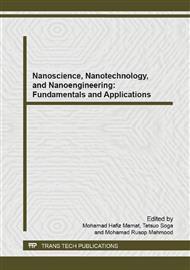p.582
p.587
p.593
p.598
p.603
p.608
p.613
p.617
p.626
ZnO Nanostructures Obtained by Mist-Atomization Method Growth on Different Au-Seeded Substrates Temperature
Abstract:
Mist-atomization deposition method was applied in order to grow ZnO nanostructures with various surface morphologies. ZnO was deposited from the mixture of zinc nitrate hexahydrate (Zn (NO3)2.6H2O) and stabilizer, hexamethylenetetramine (HMTA, C6H12N4) aqueous solutions onto Au-seeded glass substrate. The mixture was sprayed onto the surface of Au-seeded glass substrate at various growth temperatures of room temperature (RT), 100, 200, and 300 °C. The obtained structures were characterised by room-temperature photoluminescence (PL), field emission scanning electron microscopy (FESEM), and UV-VIS-NIR spectrophotometer. It is found that ZnO growth on 300 °C substrate temperature shows the best absorbance properties and highest UV emission peak with denser distribution amongst all. The optical and morphological properties of sprayed ZnO nanostructures largely depend on the substrates temperature during spraying the zinc nitrate solution and on the Au-seeded glass substrates.
Info:
Periodical:
Pages:
603-607
Citation:
Online since:
June 2015
Keywords:
Price:
Сopyright:
© 2015 Trans Tech Publications Ltd. All Rights Reserved
Share:
Citation:


